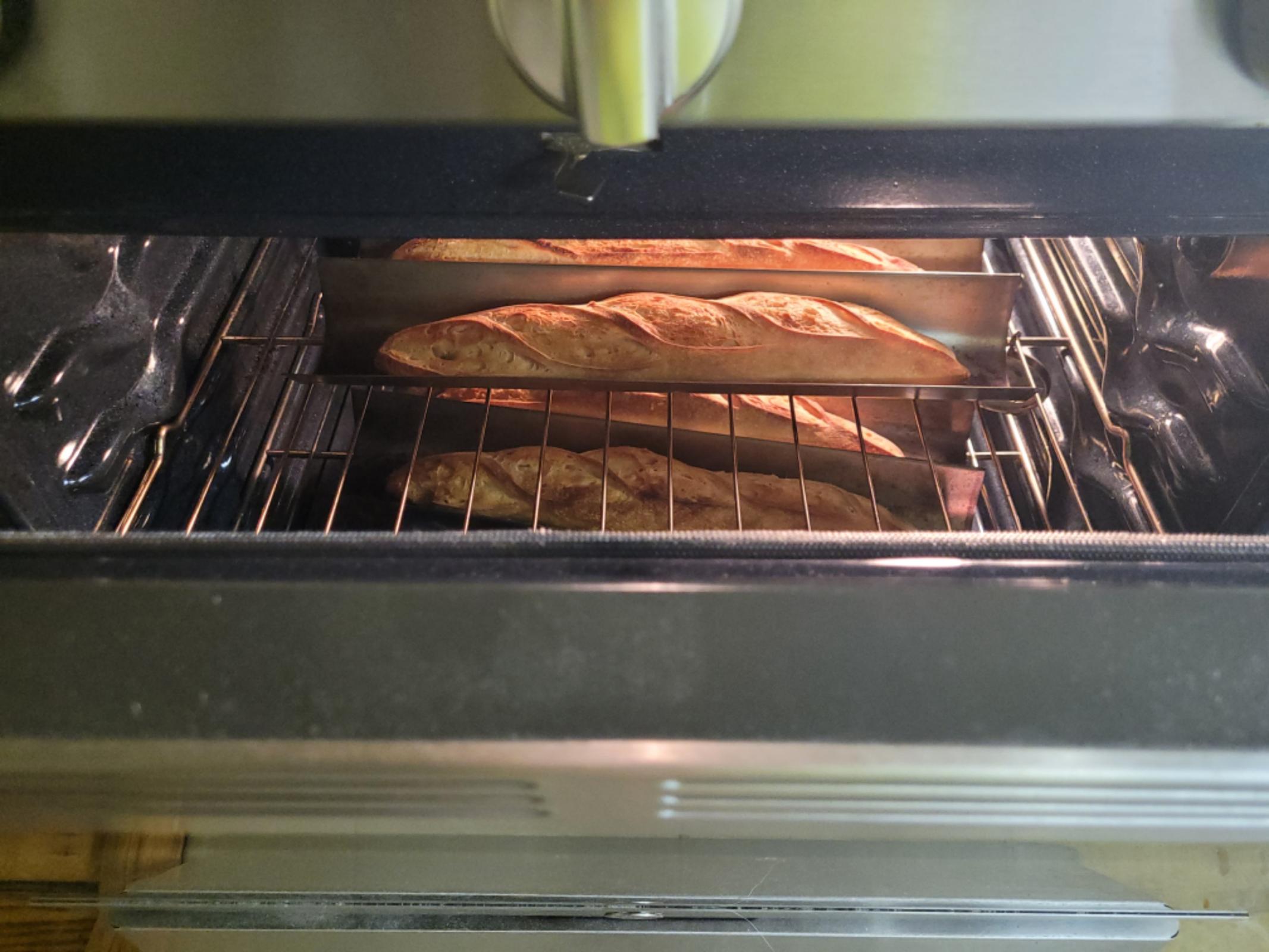February 5, 2022 - 3:13am

The stars were aligned in my favor!

Sneak peek.
You better come into my kitchen, yeah, yeah. Because it is going to be raining outdoors! The woman I love... etc, etc. Smile... The baguettes are cooling in the door cracked open turned off oven.
I made these while texting with my sister Anna. It was fun! A lesson of sorts. Smile...


on the sneak peek, these are your best yet. Really outstanding!
I am thinking, under proofed. How can I improve my crumb? For this bake, I took a commercial yeast formula I invented, and combined it with the procedure you taught me for Hamelman's Vermont sough dough! I think with a little more tweaking of the timing I will have a serious replicable formula!
on the under proofing aspect with vertical slices so the cross section distribution of the crumb is more obvious. The crumb looks fine to me otherwise, especially at the assumed lower hydration.
As far as more open crumb, a matter of hydration, more or less but not always, and the way that we treat the dough from BF onward - particularly at divide, pre-shape and shape time. Beyond that I'm not so good at giving advice on this front. There are a number of TFLers who have significantly more success and insight that I do in this arena.
with a dinner for two of meat just above it. Seems to have relatively even distribution of crumb, no long holes either. Can't see the bottom clearly, but if the crumb isn't tight at the bottom, it shouldn't be underproofed.
Maybe a "helping hand will check in on us here...
Your insight is helpful for sure. I am thinking, if the fermentation seems to be relatively on point, then the trouble of areas of slightly denser crumbs must be a handling issue. So much to learn! (My sister told me that yesterday!) LOL.
Will I’d say that the crumb some mild signs of under fermentation. I suspect that you needed to push bulk fermentation a bit further to open up the crumb. It certainly isn’t badly under fermented since the crumb isn’t severely dense and doesn’t have huge tunnels.
In terms of hydration, I so far haven’t found a huge difference in open crumb with lower vs higher hydration but of course I’ve only made baguettes over a relatively narrow range of hydration from about 68-75%. I’ve mostly been increasing hydration to get more extensible dough.
Benny
Hi, Benny.
Always happy to receive your expert advice. This particular formula is meant for an overnight 8 hrs +-. proof. At 1000 grams of flour 900AP/100 semolina 67% hydration it uses .25% (2.5G) of instant yeast. I stopped the bulk at a very roughly measured 25% (1/2") Which took 110 minutes at room temperature. Directly after the 25+-% bulk, the dough ball was weighed, divided, rested pre-shaped, and then finally shaped. Each of these steps included short rests. My thinking was the dough was still developing during the room temperature shaping. I put the quartet to sleep at exactly 11:00 PM. The cold ferment was done at 35F. (I have plenty of room to go lower if I need to. New refrigerator) After 5hrs.(At 4:00 AM) I checked in. I decided I would start the preheat and end the proof at 6Hrs. What do you think is better to go an additional 30-60 minutes at bulk or an additional hour of cold-proof? The bread was very nice to eat, that being said always room to improve.
Is my advice if you want a more open crumb. I would also recommend retarding in bulk overnight after 2 hours at RT then divide, shape and proof in around an hour. A hot stone to bake on will help a lot with oven spring and of course steam.
Did you mix it in your Bosch? I have better luck with hand mixing and a few folds because the time in the fridge will develop the gluten.
The quick fix for your next hoagie is just pluck, scrape or hollow out the crumb that is too bready. You make great pizza but you will always be The Sandwich King to me.
Don
More Air “Tastes great, less filling”
After an hour to get hydrated the dough took a quick ten-minute ride in the Bosch. Your tagline brings this quote to mind.
Jacques Pépin: "Talking about French bread some older men commented that "in the old days" a loaf would sustain you all day. Modern bread is full of holes and air. How times and tastes change."
By the way that set of triplets looks amazeballs!
Will you know what I like to do is bulk to 20% rise and then cold retard undivided overnight which you can shorten of course. Then I like to allow the dough to rise over the course of dividing, shaping and resting en couche until it has risen 30% which will mean you’ll need a jar of dough that will follow the main dough into and out of the fridge.
I didn’t realize that the dough had a significant amount of semolina in it, I do agree with Don that increasing the hydration will help with the crumb openness as I found the same when I baked 60% semolina baguettes, the crumb was better as the hydration reached 75% compared with the initial 67%. Semolina can be make quite a strong dough especially if you used machine mixing, increasing the hydration will go a long way to increasing the extensibility of the dough which should help open up the crumb.
All that said, these were lovely baguettes!
Benny